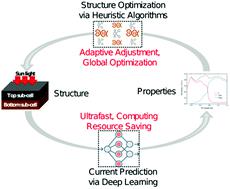当前位置:
X-MOL 学术
›
Phys. Chem. Chem. Phys.
›
论文详情
Our official English website, www.x-mol.net, welcomes your feedback! (Note: you will need to create a separate account there.)
Tandem solar cells efficiency prediction and optimization via deep learning
Physical Chemistry Chemical Physics ( IF 3.3 ) Pub Date : 2020-12-9 , DOI: 10.1039/d0cp05882c Chuqiao Yi 1, 2, 3, 4 , Yuliang Wu 4, 5, 6, 7 , Yayu Gao 1, 2, 3, 4 , Qingguo Du 4, 5, 6, 7
Physical Chemistry Chemical Physics ( IF 3.3 ) Pub Date : 2020-12-9 , DOI: 10.1039/d0cp05882c Chuqiao Yi 1, 2, 3, 4 , Yuliang Wu 4, 5, 6, 7 , Yayu Gao 1, 2, 3, 4 , Qingguo Du 4, 5, 6, 7
Affiliation

|
Optical design plays an important role in improving the performance of opto-electronic devices. However, conventional design processes using finite difference time domain (FDTD) or finite element methods are usually time and computing resource consuming, and often result in sub-optimal solutions due to an incomplete search of the parameter state space. In this paper, we propose a deep learning approach to predict and optimize the cell performance of perovskite/crystalline-silicon (c-Si) tandem solar cells. In particular, a deep neural network is established to predict the achievable short-circuit current for tandem solar cells with a given cell structure. After training on a FDTD numerical simulation data set, the proposed deep neural network achieves an accuracy of 98.3% and micro-second grade simulation time, which is an ultra-fast, highly accurate and computing resource-saving solution to investigate the current properties of tandem solar cells. Heuristic algorithms are further adopted to inversely optimize the device structure, where the optimal set of layer thicknesses is obtained to maximize the achievable short-circuit current. According to the calculated projected efficiency, the expected experimental short-circuit current and power conversion efficiency of tandem solar cells with the optimal selection of layer thickness can reach 15.79 mA cm−2 and 23.24%, which is improved by 14.42% and 28.4%, respectively, compared to the benchmark cells.
中文翻译:

通过深度学习进行串联太阳能电池效率预测和优化
光学设计在提高光电设备的性能方面起着重要作用。但是,使用有限差分时域(FDTD)或有限元方法的常规设计过程通常会浪费时间和计算资源,并且由于对参数状态空间的不完全搜索而常常导致次优解决方案。在本文中,我们提出了一种深度学习方法来预测和优化钙钛矿/晶体硅(c-Si)串联太阳能电池的电池性能。特别是,建立了一个深层神经网络来预测具有给定电池结构的串联太阳能电池可实现的短路电流。在对FDTD数值模拟数据集进行训练之后,拟议的深度神经网络实现了98.3%的精度和微秒级的模拟时间,这是一个超快的,高度精确和节省资源的解决方案,用于研究串联太阳能电池的当前特性。进一步采用启发式算法来逆向优化器件结构,在该结构中,获得了一组最佳的层厚度以最大化可实现的短路电流。根据计算出的预计效率,具有最佳层厚度选择的串联太阳能电池的预期实验短路电流和功率转换效率可达到15.79 mA cm-2和23.24%,与基准电池相比分别提高了14.42%和28.4%。
更新日期:2021-01-22
中文翻译:

通过深度学习进行串联太阳能电池效率预测和优化
光学设计在提高光电设备的性能方面起着重要作用。但是,使用有限差分时域(FDTD)或有限元方法的常规设计过程通常会浪费时间和计算资源,并且由于对参数状态空间的不完全搜索而常常导致次优解决方案。在本文中,我们提出了一种深度学习方法来预测和优化钙钛矿/晶体硅(c-Si)串联太阳能电池的电池性能。特别是,建立了一个深层神经网络来预测具有给定电池结构的串联太阳能电池可实现的短路电流。在对FDTD数值模拟数据集进行训练之后,拟议的深度神经网络实现了98.3%的精度和微秒级的模拟时间,这是一个超快的,高度精确和节省资源的解决方案,用于研究串联太阳能电池的当前特性。进一步采用启发式算法来逆向优化器件结构,在该结构中,获得了一组最佳的层厚度以最大化可实现的短路电流。根据计算出的预计效率,具有最佳层厚度选择的串联太阳能电池的预期实验短路电流和功率转换效率可达到15.79 mA cm-2和23.24%,与基准电池相比分别提高了14.42%和28.4%。


























 京公网安备 11010802027423号
京公网安备 11010802027423号